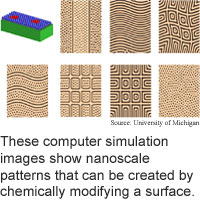
Simulation maps nano patterns
Microscopic machines promise to be useful
in manufacturing materials molecule-by-molecule and eventually for applications
like targeted drug delivery. But to construct a nanoscale machine you
must figure out how to fabricate parts that are not much bigger than molecules.
Researchers from the University of Michigan have used a computer
simulation to develop a method of chemically building nanoscale patterns
on a surface. The patterns, which include neatly-positioned groups of
wavy and straight lines, dots, boxes within boxes, and mixes of dots and
lines, would be relatively inexpensive to produce and could form the basis
for nanoscale machines.
To make the patterns, the researchers simulated the application
of monolayers, or single-molecule layers of material, to an elastic substrate.
Different materials self-assembled into different patterns. A partial-monolayer
of oxygen on a monolayer of copper, for instance, forms regular, 10-nanometer
stripes of oxygen alternating with bare copper. And a mix of copper and
lead on copper forms ordered patterns of dots or stripes depending on
the mix percentages. A nanometer is one millionth of a millimeter.
Key to the process is the surface chemistry, which governs how
the atoms of the two layers interact on a uniform surface. The choice
of materials determines the type, size and alignment of the pattern.
The researchers are working to expand the method to fabricate
more complicated structures.
The process could be used practically in two to five years, according
to the researchers. The work appeared in the February 11, 2004 issue of
Nano Letters.
Net plan builds in search
Robot guided by its voice
Angle speeds plastic transistor
Sturdy quantum computing demoed
Briefs:
DNA folds into paired pyramids
Fiber spun from nanotube smoke
Material boosts thermoelectricity
Nano ribbons coil into rings
Simulation maps nano patterns
Chip-camera combo tracks viruses

Research Watch blog
View from the High Ground Q&A
How It Works
RSS Feeds:
News
Ad links:
Buy an ad link
Ad links: Clear History
Buy an ad link
|
TRN
Newswire and Headline Feeds for Web sites
|
© Copyright Technology Research News, LLC 2000-2010. All rights reserved.